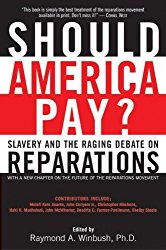|
Henry
Louis Gates recently wrote an Op-Ed article that appeared in the New
York Times on April 23, 2010, essentially attempting to
re-conceptualize the reparations issue by implying that history is
too complicated to bring about a “just and lasting agreement on
the divisive issue of slavery reparations.”
In
my view, Professor Gates is “dead wrong” and we should
begin reviewing the history of the Reparations Movement by reading
and re-reading Dr. Raymond Winbush’s book on this subject.
A
few years ago a new book on the African in America Reparations
Movement was released. The title of the book, edited by Dr. Raymond
A. Winbush, the Director of the Institute for Urban Research at
Morgan State University is Should America Pay?


In
February 2001, Dr. Winbush, who was formerly the Director of Fisk
University’s Race Relations Institute, sponsored a two-day
conference on slavery and reparations that brought together leading
researchers, politicians, historians, and activists from throughout
the country to dialogue on the issue of Reparations for African
people in America.
The
conference was so successful that Dr. Winbush suggested that several
of the presenters be included in a book he was proposing, which would
entail several articles addressing the broad spectrum of the
reparations debate in this country.
Dr.
Winbush has emerged as one of the leading scholar/activists in this
country, and throughout the world, and has used his considerable
skills as a researcher and writer to become the editor of this newly
released book, Should America Pay?
What
makes this book, perhaps one of the most significant and
comprehensive books published on the issue of reparations for African
people in America is that it thoroughly covers the broad spectrum of
this movement in six sections with more than twenty articles that
address: Part I – History and Reparations, Part II –
Reparations and the Law, Part III – Voices For and Against
Reparations, Part IV – Reparations and Grassroots Organizing,
Part V – Reparations and Intervention, and Part VI –
Historical Documents.
The
worldwide African Reparations Movement has become unified around the
fact that the Trans Atlantic Slave Trade, Slavery, and Colonialism
were Crimes Against Humanity. This unity impacted the United Nations
World Conference Against Racism that was held in Durban, South Africa
in August and September 2001, to officially declare in the conference
outcome that the Trans Atlantic Slave Trade and Slavery was a Crime
Against Humanity.
The
momentum gained by African people who participated in the United
Nations World Conference Against Racism, particularly the Durban 400,
organized by the December 12th Movement and the National
Black United Front, led to “The Call” for the
Millions For Reparations Mass Rally held in Washington, D. C. on
August 17, 2002. More than fifty thousand African people from
thirty-eight states and sixty-six cities participated in this all day
rally, whose theme was “THEY OWE US.”
Against
this backdrop, Should America Pay? has now been published by
Amistad: An Imprint of Harper Collins Publishers.
In
the introduction chapter Dr. Winbush writes, “As this book goes
to press the reparations movement, historically considered a fringe
issue in the American Black nationalist community, is now firmly
established among various constituencies in the United States as well
as in African communities around the world. Its ascendancy as an
important social movement— I would argue the most important
since Civil Rights— is confirmed by the amount of print space
and air time the media devote to it.”
Winbush
continues by observing, “Though the movement is picking up
speed, compensatory measures for Africans have been elusive because
of the entrenchment of white supremacy in world politics that
provided legal sanction for this crime against humanity.”

Perhaps
the most significant aspect of, Should America Pay? is the
framework Dr. Winbush develops in his introductory chapter for
understanding the rise of the Reparations Movement.
Dr.
Winbush explains, “A convergence of four groups provides a
conceptual framework for understanding the current discussion of
reparations: 1) grassroots organizers, 2) legislators, 3) attorneys,
and 4) academics. A similar convergence of cooperation occurred
during the late 1940s and resulted in what we now call the Civil
Rights Movement.”
In
this context, Dr. Winbush makes the analogy that, “Reparations
have a similar history. Grassroots organizations such as the December
12th Movement (D12), National Coalition of Blacks for
Reparations in America (N`COBRA), and the National Black United Front
(NBUF) worked closely with legislators in the mid-1980s. John Conyers
Jr. (D-MI) for example, and collaborated with the Reparations
Coordinating Committee (RCC), consisting of attorneys such as Willie
Gary, Randall Robinson, and Johnnie Cochran and academics such as
Manning Marble and Ron Walters.”
Dr.
Winbush writes, “These groups conversed long and hard with each
other, and as you will see, these discussions were often heated and
difficult. What united them, however, was a goal of pressing for
reparations on a global level for African people.”
I
encourage those of you who are interested in learning more about the
Reparations Movement to purchase this book. In my judgment, Should
America Pay? will be the definitive textbook on the
Reparations Movement with contributing chapters from Molefi Asanté,
John Conyers Jr., Deadria C. Farmer-Paellmann, Wade Nobles, Adjoa A.
Aiyetoro, Roger Wareham, and others. And yes, I even have two
chapters in this most outstanding contribution to the continued rise
of the Reparations Movement in America.
|

